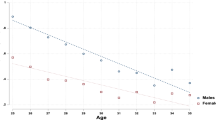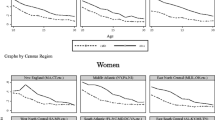Abstract
This paper is the first study of which the author is aware that examines elderly Indonesians’ residency decisions. The 1993 Indonesian Family Life Survey provides detailed data on the living children of a sample of elderly individuals. This allows a nested logit to be estimated, which pays due respect to the role of children’s characteristics in determining the residency outcome. The estimated earnings potentials of the parents and their children are included as explanatory variables but are not found to be important determinants of coresidency.
Similar content being viewed by others
References
Andrews, G.R., A.J. Esterman, A.J. Braunack-Mayer, and C.M. Rungie. 1986. Aging in the Western Pacific: A Four Country Study. Manila: World Health Organization.
DaVanzo, J. and A. Chan. 1994. “Living Arrangements of Older Malaysians: Who Coresides With Their Children?” Demography 31:95–113.
Evans, J. 1990. “The Economic Status of Older Men and Women in the Javanese Household and the Influence of This Upon Their Nutritional Level.” Journal of Cross-Cultural Gerontology 5:217–42.
Hensher, D.A. 1986. “Sequential and Full Information Maximum Likelihood Estimation of a Nested Logit Model.” Review of Economics and Statistics 68(4):657–67.
Hoffman, S. and G. Duncan. 1988. “A Comparison of Choice-Based Multinomial and Nested Logit Models: The Family Structure and Welfare Use Decisions of Divorced or Separated Women.” Journal of Human Resources 23(4):550–62.
Kim, I. and E. Choe. 1992. “Support Exchange Patterns of the Elderly in the Republic of China.” Asia-Pacific Population Journal 7(3):89–104.
Maddala, G.S. 1983. Limited Dependent and Qualitative Variables in Econometrics. Cambridge, UK: Cambridge University Press.
Martin, L. 1988. “The Aging of Asia.” Journal of Gerontology 43:S99–113.
— 1989. “Living Arrangements of the Elderly in Fiji, Korea, Malaysia and the Philippines.” Demography 26:627–44.
McFadden, D. 1984. “Econometric Analysis of Qualitative Response Models.” Pp. 1396–457 in Handbook of Econometrics, Vol. 2, edited by Z. Griliches and M. Intriligator. Amsterdam: North-Holland.
Rudkin, L. 1993. “Gender Differences in Economic Well-Being Among the Elderly of Java.” Demography 30:209–26.
— 1994. “Dependency Status and Happiness With Old Age on Java.” The Gerontologist 34(2):217–23.
Wolf, D. and B. Soldo. 1988. “Household Composition Choices of Older Unmarried Women.” Demography 25:387–403.
World Bank. 1995. The World Development Report. New York: Oxford University Press.
Author information
Authors and Affiliations
Corresponding author
Additional information
I am thankful to Deborah Cobb-Clark, Tom Crossley, Guay Lim, Chris Worswick, and attendees at the 1998 Labour Econometrics Workshop at the Australian National University for helpful comments on this paper. I also gratefully acknowledge funding from Australian Research Council Grant S79813009. All errors are my own. Demography, Volume 37-Number 1, February 2000: 17-27
Rights and permissions
About this article
Cite this article
Cameron, L. The residency decision of elderly indonesians: A nested logit analysis. Demography 37, 17–27 (2000). https://doi.org/10.2307/2648093
Issue Date:
DOI: https://doi.org/10.2307/2648093




